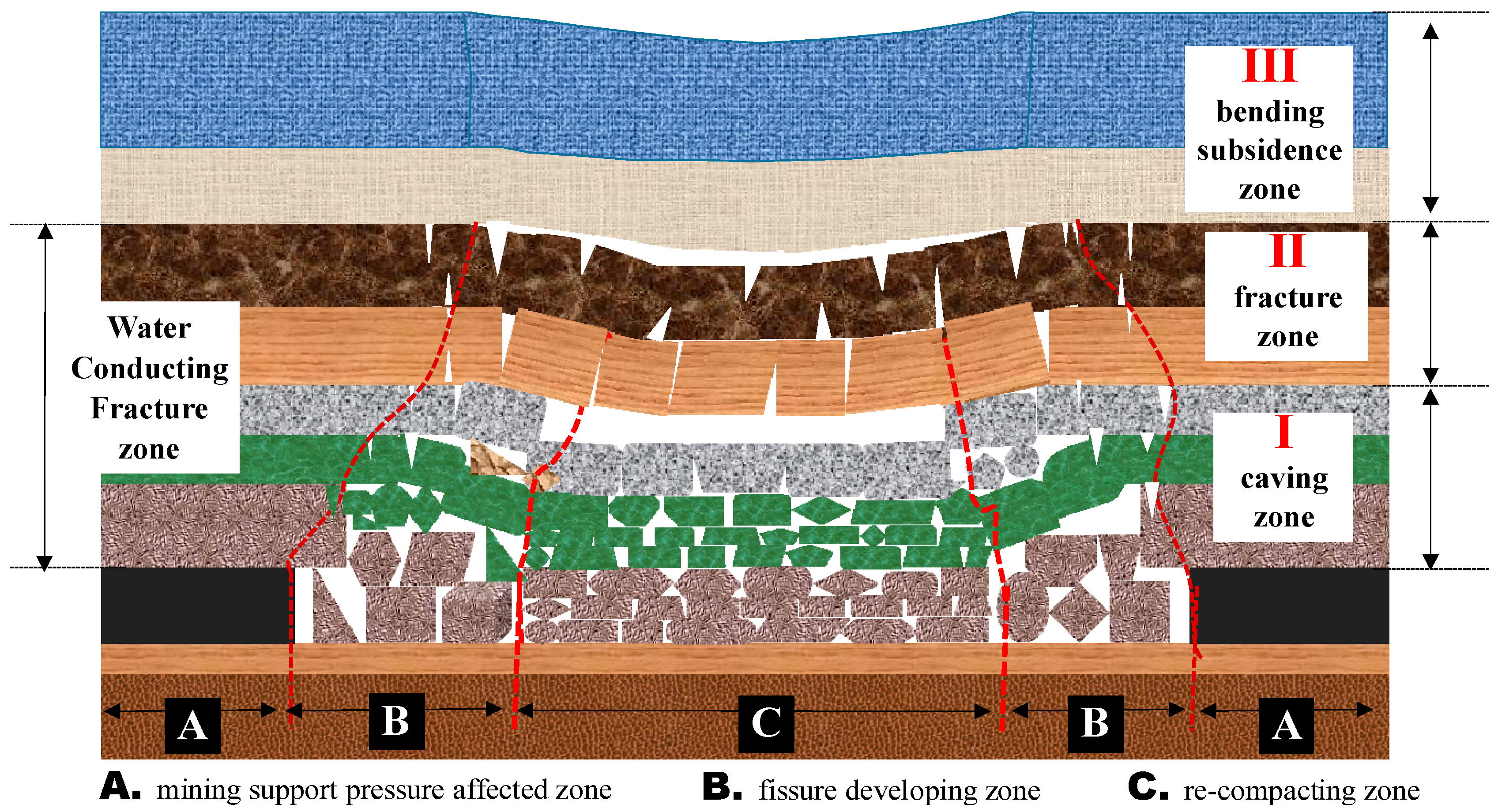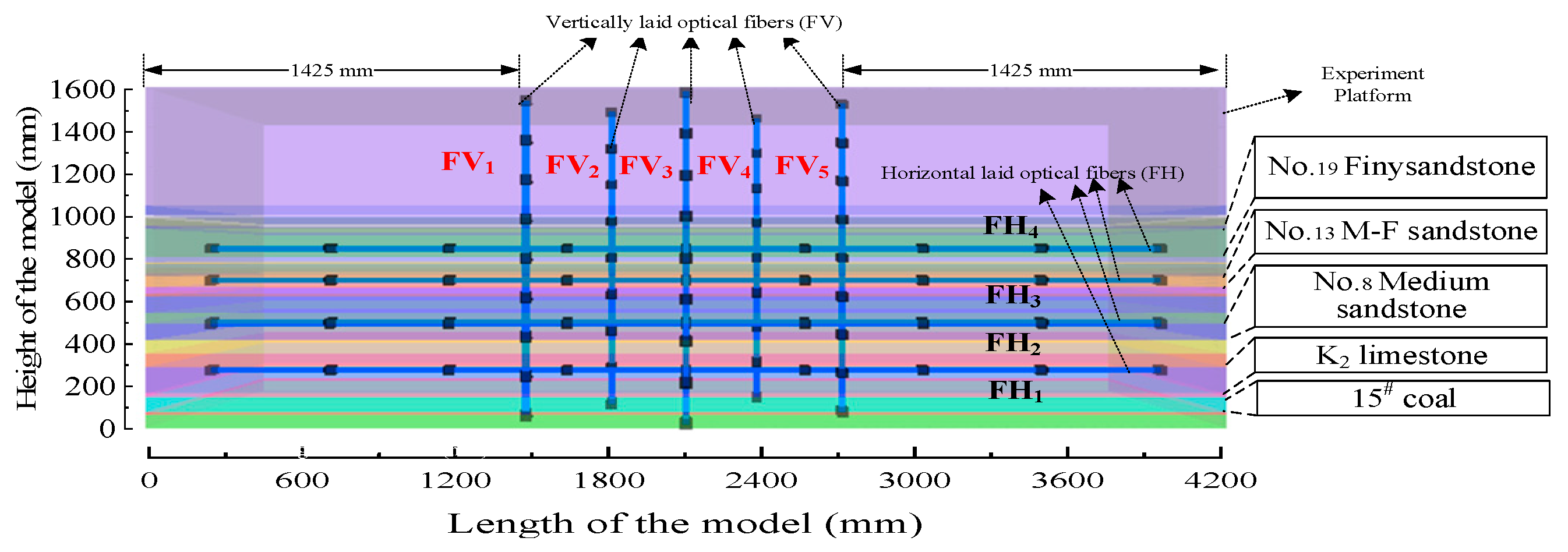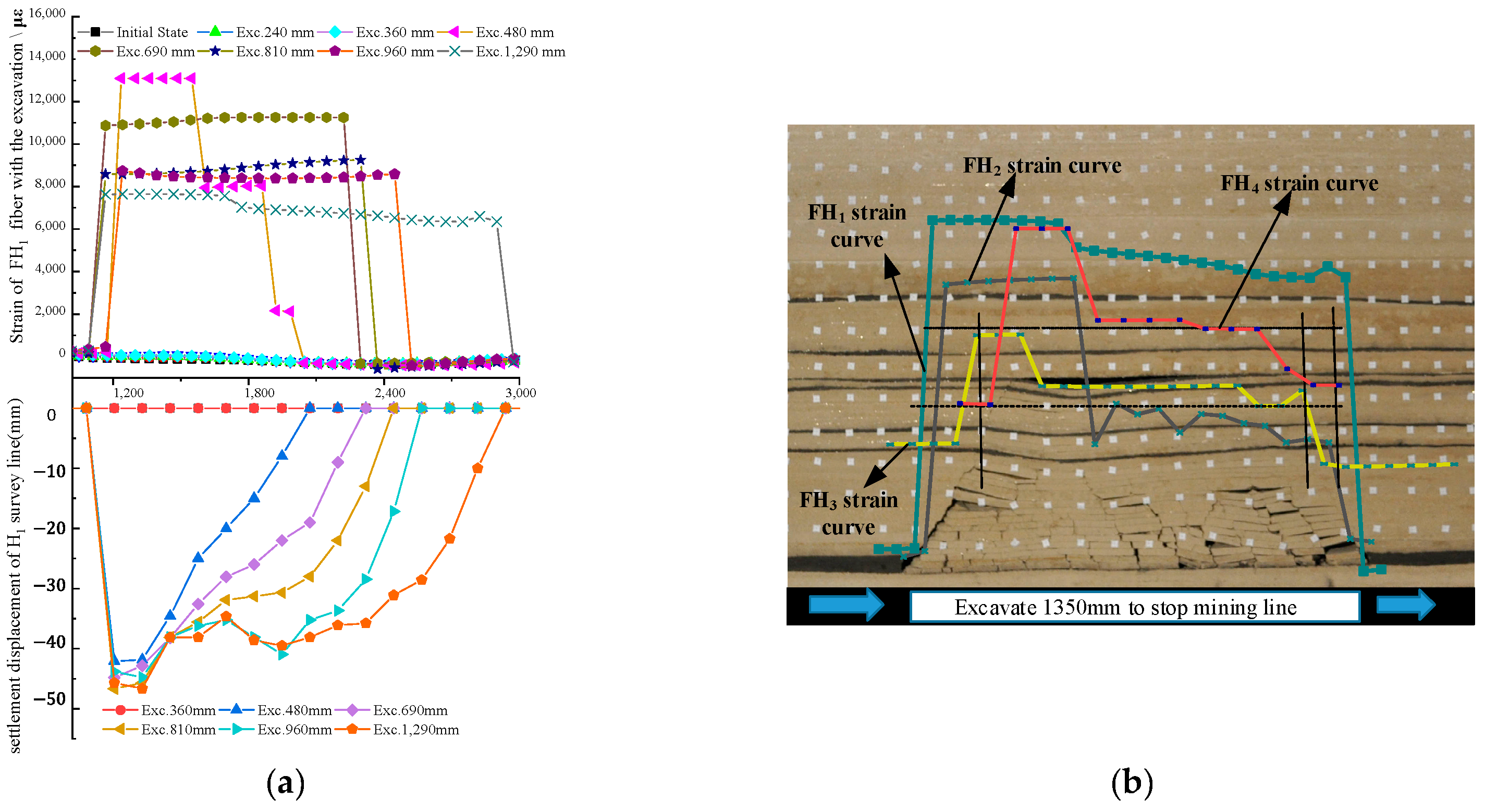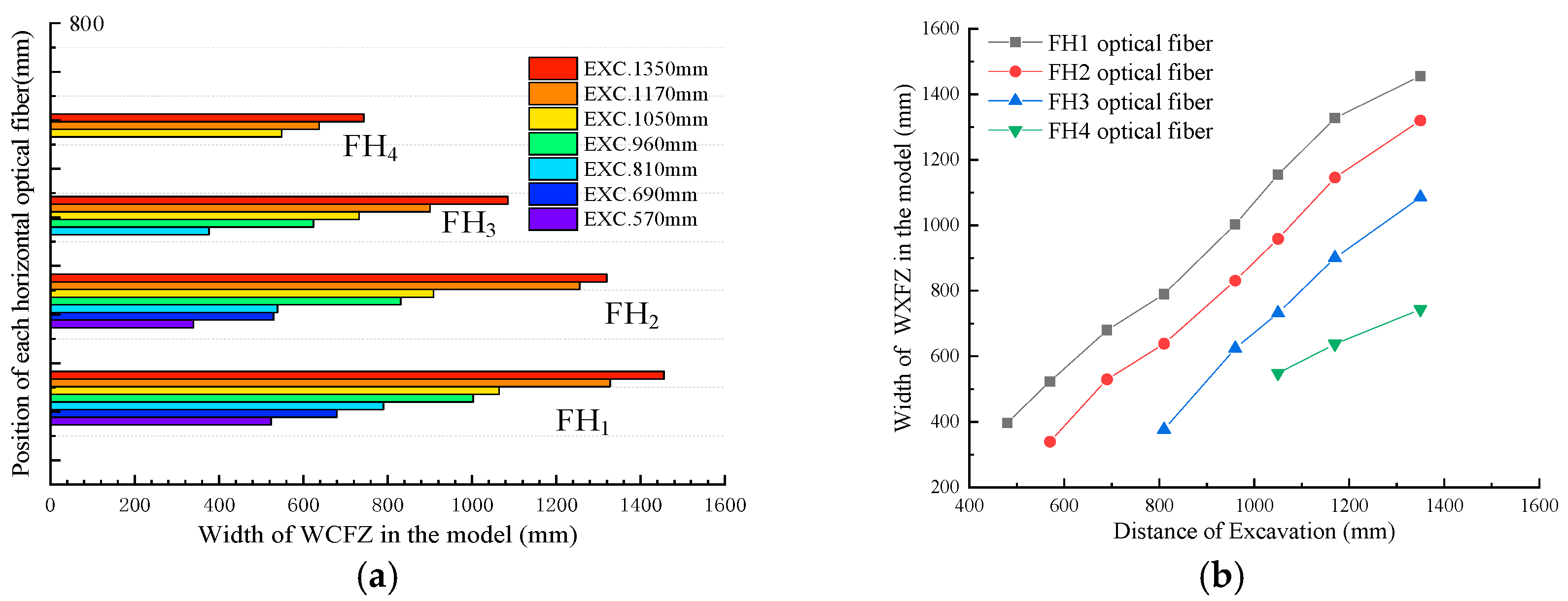Development Law of Water-Conducting Fracture Zones in Overburden above Fully Mechanized Top-Coal Caving Face: A Comprehensive Study
Abstract
:1. Introduction
2. Project Profile
2.1. Engineering Outline
2.2. Hydrogeological Engineering Geology and Coal Measure Strata
2.2.1. Hydrogeological Engineering Geology
2.2.2. Coal Measure Strata
2.3. Brief Description of the 150313 Working Face in Yinying Coal Mine
3. Height Prediction of the WCFZ in a Fully Mechanized Mining Face
4. Numerical Simulation of the WCFZ Height
4.1. Contour Maps of Z-Displacement in the Simulation Process
4.2. Distribution of Plastic Zones in Overlying Strata
4.3. Distribution of Vertical Stress in Overburden Strata
4.4. Displacement Analysis of Survey Line
4.4.1. Horizontal Survey Line for Monitoring the Settlement of Overburden
4.4.2. Vertical Settlement of Survey Lines at Various Heights in the Model
4.4.3. Vertical Survey Line for Monitoring the Settlement of Overburden
5. Similar Simulation Physical Experiment for a Movement Law of the WCFZ
- The position of the KS in the overlying rock will affect the height of the WCFZ. Only when the distance between the KS and the mined coal seam is less than a certain critical height, the fractures in the KS will penetrate and become water-conducting fractures. Moreover, the fractures in the overlying rock layer controlled by the KS will also penetrate and become water-conducting fractures.
- The critical height for the breakthrough of KS fractures can be roughly estimated as (7–10) M (where M is the coal seam cutting thickness). When the PKS of the overlying rock is located within the critical height (7~10) M, the WCFZ will develop to the top of the bedrock, and the height of the WCFZ will be equal to or greater than the thickness of the bedrock.
- When the distance from the PKS to the coal seam is greater than (7~10) M, the WCFZ in the roof will develop to the position below the nearest KS being (7~10) M more away from the coal seam, and then, the height of the WCFZ equals the distance of the KS to the coal seam.
5.1. Outline of the Similar Simulation Experiment
5.2. Layout of Optical Fiber Monitoring System and CRP System
5.2.1. Layout of Optical Fibers in the Model
5.2.2. The Close-Range Photogrammetry System
5.2.3. The Principle of BOFDA Monitoring and Close-Range Photogrammetry
- BOFDA
- CRP
5.3. Similar Simulation Model Experiments of Overburden Deformation Movement
5.3.1. Experimental Process and Theoretical Analysis of Key Strata in the Experiment
5.3.2. Optical Fiber Strain Characterization of the Height and Range of WCFZ
- Characterization of the development law of the WCFZ by vertical optical fiber strain
- Characterization of the developing law of the WCFZ by horizontal optical fiber strain
- Optic fiber strain characterization of the WCFZ in space and time based on BOFDA
6. Discussions
7. Conclusions
- Research has found that the No. 24 K7 sandstone layer is the primary key strata, and the No. 7 fine sandstone and the No. 13 medium-fine sandstone are the subkey strata in the overlying rock of the 150313 working face; they dominate and control the developmental height of the WCFZ in the 150313 working face.
- When the critical distance of the primary key strata is less than 10 times the mining height, the application of standard formulas to calculate the WCFZ is effective. Otherwise, the fracture zone will develop to the surface. The height of the WCFZ is below the PKS in this study, which is the No. 24 coarse sandstone.
- The optical fiber strain presents a multi-step boss curve as the working face is being excavated. For vertical optical fiber, the height of the lower boundary of the boss represents the height of the caving zone, while the height of the upper boundary represents the height of the WCFZ. For the horizontal optical fiber, the width of the boss strain curve presents the developing width of the WCFZ.
- The WCFZ exhibits a dynamic development rightward and upward in an unequal trapezoidal shape during the excavation of the working face.
- The WCFZ height of the 150313 working face in the comprehensive mechanized top-coal mining is 89.36 m with a fracture/mining ratio of 12.46, and the height of the caving zone is determined as 28.63 m with a caving/mining ratio of 3.96.
Author Contributions
Funding
Data Availability Statement
Acknowledgments
Conflicts of Interest
References
- Feng, D.; Hou, E.; Wang, S.; Xie, X.; Yuan, F.; Guo, L.; Wang, G.; Xie, Y.; Chen, Z. Research on 3D development characteristics of water-conducting fractured zone based on field measurement. Front. Earth Sci. 2022, 10, 808931. [Google Scholar] [CrossRef]
- Zhang, F.; Wang, G.; Wang, B. Study and application of high-level directional extraction borehole based on mining fracture evolution law of overburden strata. Sustainability 2023, 15, 2806. [Google Scholar] [CrossRef]
- Xu, B.; Xu, W.; Zhang, Y. Experimental Study on the Characteristics of Overlying Rock Movement in Mining Area. Geotech. Geol. Eng. 2024, 42, 1779–1791. [Google Scholar] [CrossRef]
- Zhang, L.; Zhang, Z.; Wang, K.; Tan, X.; Zhang, T.; Zhang, L. Characteristic developments of the water-conducting fracture zones in weakly cemented overlying strata of Jurassic coal mines in Western China. Water 2023, 15, 1097. [Google Scholar] [CrossRef]
- Wang, H.; Zhu, J.; Li, W. An Improved Back Propagation Neural Network Based on Differential Evolution and Grey Wolf Op-timizer and Its Application in the Height Prediction of Water-Conducting Fracture Zone. Appl. Sci. 2024, 14, 4509. [Google Scholar] [CrossRef]
- Pei-ding, Z.; Chao-shang, S.; Xuan, F.; Song-tao, L.; Long-jing, W.; Zheng-zheng, C. Temporal and Spatial Evolution Mechanisms of the Water-Conducting Fractured Zone of Overlying Strata in the Kongzhuang Coal Mine. Geofluids 2023, 2023, 3790998. [Google Scholar] [CrossRef]
- Hu, T.; Hou, G.; Bu, S.; Zhu, Z.; Wang, Y.; Hu, Z.; Li, Z. A novel approach for predicting the height of water-conducting fracture zone under the high overburden caving strength based on optimized processes. Processes 2020, 8, 950. [Google Scholar] [CrossRef]
- Wei, D.; Gu, H.; Wang, C.; Wang, H.; Zhu, H.; Guo, Y. Extension Mechanism of Water-Conducting Cracks in the Thick and Hard Overlying Strata of Coal Mining Face. Water 2024, 16, 1883. [Google Scholar] [CrossRef]
- Zhang, L.; Zhang, Z.; Wang, K.; Tan, X.; Zhang, L.; Zhang, T. Development and Height Prediction of Fractured Water-Conducting Zone in Weakly Cemented Overburden: A Case Study of Tashidian Erjingtian Mine. Sustainability 2023, 15, 13899. [Google Scholar] [CrossRef]
- Zhengzheng, C.; Xiangqian, Y.; Zhenhua, L.; Feng, D. Evolution mechanism of water-conducting fractures in overburden under the influence of water-rich fault in underground coal mining. Sci. Rep. 2024, 14, 5081. [Google Scholar] [CrossRef]
- Chang, X.; Wang, M.; Zhu, W.; Fan, J.; Liu, M. Study on height development characteristics of water-conducting fracture zone in fully mechanized mining of shallow thick coal seam under water. Sustainability 2023, 15, 7370. [Google Scholar] [CrossRef]
- Mai, L.; Li, H. Finite–Discrete Element Method Simulation Study on Development of Water-Conducting Fractures in Fault-Bearing Roof under Repeated Mining of Extra-Thick Coal Seams. Sustainability 2024, 16, 5177. [Google Scholar] [CrossRef]
- Gao, Z.; Jin, L.; Liu, P.; Wei, J. Height Prediction of Water-Conducting Fracture Zone in Jurassic Coalfield of Ordos Basin Based on Improved Radial Movement Optimization Algorithm Back-Propagation Neural Network. Mathematics 2024, 12, 1602. [Google Scholar] [CrossRef]
- State Administration of Safety Production, State Administration of Coal Mine Safety Supervision, State Energy Administration, State Railway Administration. Regulations for Retaining Coal Pillars and Coal Mining in Buildings, Water Bodies, Railways, and Main Mines [L]. May 17, 2017. Available online: https://www.mem.gov.cn/gk/gwgg/201707/W020190911694189457062.pdf (accessed on 29 August 2024). (In Chinese)
- Liu, Z.; Yang, B.S. Using numerical simulation methods to determine the development height of water conducting fracture zones Mining Safety and Environmental Protection. Min. Saf. Environ. Prot. 2006, 33, 16–19. (In Chinese) [Google Scholar]
- Zhang, Z.; Dai, L.; Sun, H.; Liu, Y.; Yang, H.; Li, R.; Zhang, Y. Study on the spatiotemporal dynamic evolution law of a deep thick hard roof and coal seam. Processes 2023, 11, 3173. [Google Scholar] [CrossRef]
- Du, F.; Zhang, Y.; Dai, L.; Cui, W.; Wang, B.; Sun, J. Research on Multi-Physical Field Characteristics of Deep Coal Seam Mining Based on the Rock-Coal-Rock Model. Processes 2024, 12, 726. [Google Scholar] [CrossRef]
- Guo, W.; Zhao, G.; Lou, G.; Wang, S. A new method of predicting the height of the fractured water-conducting zone due to high-intensity longwall coal mining in China. Rock Mech. Rock Eng. 2019, 52, 2789–2802. [Google Scholar] [CrossRef]
- Qian, M.G.; Xu, J. Behaviors of strata movement in coal mining. J. China Coal Soc. 2019, 44, 973–984. (In Chinese) [Google Scholar]
- Hu, G.L.; Zhu, W.B.; Wang, X.Z. New method to predict the height of fractured water-conducting zone by location of key strata. J. China Coal Soc. 2012, 37, 762–769. (In Chinese) [Google Scholar]
- Wang, Z.Q.; Li, P.F.; Wang, L.; Gao, Y.; Guo, X.F.; Chen, C.F. Method of division and engineering use of “three band” in the stope again. J. China Coal Soc. 2013, 38, 287–293. (In Chinese) [Google Scholar]
- Chen, X.; Huang, Z.; Wang, L.; Dong, X.; Cui, P. Determination of the Height of Overburden Water-Conducting Fracture Zone in 215102 Working Face of Yue Nan Coal Mine. Geofluids 2022, 2022, 3124374. [Google Scholar] [CrossRef]
- Garus, D.; Krebber, K.; Schliep, F.; Gogolla, T. Distributed sensing technique based on Brillouin optical-fiber frequency-domain analysis. Opt. Lett. 1996, 21, 1402–1404. [Google Scholar] [CrossRef] [PubMed]
- Hartog, A.H. An Introduction to Distributed Optical Fiber Sensors; CRC Press: Boca Raton, FL, USA, 2017. [Google Scholar]
- Wang, X.; Shi, B.; Wei, G.; Chen, S.E.; Zhu, H.; Wang, T. Monitoring the behavior of segment joints in a shield tunnel using distributed fiber optic sen-sors. Struct. Control. Health Monit. 2017, 25, e2056. [Google Scholar] [CrossRef]
- Wang, X.; Shi, B.; Wei, G.Q.; Cheng, G.; Zgang, C. Performance and characteristics of BOFDA, a new monitoring technology for civil and geotechnical engineering. J. Disaster Prev. Mitig. Eng. 2015, 35, 763–768. [Google Scholar]
- Zhang, Q.; Xiong, Z. Crack detection of reinforced concrete structures based on BOFDA and FBG sensors. Shock. Vib. 2018, 2018, 6563537. [Google Scholar] [CrossRef]
- Ding, Y.; Shi, B.; Cui, H.; Suo, W.; Liu, J. Application of Optical Fiber Sensing Network in Slope Stability Monitoring. J. Geotech. Eng. 2005, 27, 338–342. (In Chinese) [Google Scholar]
- Shi, B.; Xu, H.Z.; Zhang, D.; Ding, Y.; Cui, H.L.; Chen, B.; Gao, J.Q. Feasibility study on application of BOTDR to health monitoring for large infrastructure engineering. Chin. J. Rock Mech. Eng. 2004, 23, 493–499. (In Chinese) [Google Scholar]















| No. | Lithology | Bulk Modulus (Gpa) | Shear Modulus (GPa) | Density (kg/m3) | Internal Friction Angle (o) | Cohesion (Mpa) | Tensile Strength (Mpa) |
|---|---|---|---|---|---|---|---|
| 25 | Permian Shanxi Formation | 5.23 | 4.8 | 2500 | 50 | 3.3 | 2.00 |
| 24 | K7 Coarse Sandstone | 9.78 | 8.51 | 2470 | 58 | 6 | 2.00 |
| 23 | Medium Sandstone | 9.44 | 7.94 | 2590 | 50 | 5.5 | 2.67 |
| 22 | 9# Coal with mud shale | 4.52 | 3.89 | 1540 | 28 | 1.8 | 1.00 |
| 21 | Fine Sandstone | 4.08 | 6.8 | 2810 | 35 | 4 | 2.17 |
| 20 | Mud Shale | 3.46 | 2.78 | 2660 | 29 | 2.2 | 2.13 |
| 19 | K4 Limestone | 8.19 | 7.18 | 2660 | 43 | 3.3 | 1.70 |
| 18 | Mud Shale | 3.62 | 2.58 | 2450 | 28 | 1.9 | 0.67 |
| 17 | Medium Sandstone | 8.54 | 6.75 | 2600 | 51 | 5 | 1.26 |
| 16 | Sandstone–Shale interbed | 5.67 | 5.38 | 2660 | 39 | 4.2 | 1.67 |
| 15 | 12# Coal | 3.3 | 2.98 | 1390 | 30 | 2.1 | 1.00 |
| 14 | Medium-Fine Sandstone | 8.26 | 7.72 | 2750 | 54 | 5.3 | 1.69 |
| 13 | K3 Limestone | 6.44 | 5.92 | 2800 | 43 | 3.3 | 1.97 |
| 12 | 13# Coal | 3.52 | 3.46 | 1380 | 29 | 2.0 | 1.00 |
| 11 | Medium-Fine Sandstone | 7 | 6.66 | 2580 | 50 | 5 | 2.5 |
| 10 | Fine Sandstone | 7.24 | 6.96 | 2870 | 57 | 4.4 | 1.67 |
| 9 | Medium Sandstone | 8.21 | 6.94 | 2590 | 52 | 5 | 2.67 |
| 8 | Fine Silt Stone | 7.62 | 6.82 | 2640 | 46 | 4.1 | 2.00 |
| 7 | Mud Shale | 3.47 | 3.26 | 2660 | 31 | 2.2 | 2.13 |
| 6 | K2 Limestone | 7.48 | 7.23 | 2720 | 47 | 3.5 | 2.08 |
| 5 | Mudstone | 2.79 | 2.55 | 2540 | 37 | 1.3 | 1.00 |
| 4 | 15# Coal | 3.89 | 2.96 | 1360 | 35 | 1.8 | 2.41 |
| 3 | Sandy Mudstone | 6.74 | 6.57 | 2530 | 29 | 2.0 | 1.00 |
| 2 | Medium Sandstone | 8 | 7.66 | 2580 | 48 | 4.3 | 2.5 |
| 1 | K1 Sandstone | 8.08 | 7.47 | 2640 | 54 | 5 | 2.00 |
| Parameter Type | The Value of the Parameter |
|---|---|
| Type of the optical fiber | Single mode |
| Spatial resolution/m | 0.2 |
| Highest sampling resolution/m | 0.05 |
| Accuracy of strain testing/με | ±2 |
| Strain test repeatability/με | ≤±4 |
| Strain test range/με | −15,000~+15,000 |
| Frequency sweep range/GHz | 9.9~12.0 |
| Research Methods | Height of WCFZ | Height of Caving Zone | Fracture/Mining Ratio | Caving/Mining Ratio |
|---|---|---|---|---|
| Regulation formula | 90.666 m | 30.125 m | 12.54 | 4.17 |
| Numerical simulation | 86.5 m | 30 m | 11.96 | 4.15 |
| Key strata | 90 m | - | 12.45 | - |
| Physical simulation | 90.27 m | 25.77 m | 12.49 | 3.56 |
| Average value | 89.36 m | 28.63 m | 12.46 | 3.96 |
Disclaimer/Publisher’s Note: The statements, opinions and data contained in all publications are solely those of the individual author(s) and contributor(s) and not of MDPI and/or the editor(s). MDPI and/or the editor(s) disclaim responsibility for any injury to people or property resulting from any ideas, methods, instructions or products referred to in the content. |
© 2024 by the authors. Licensee MDPI, Basel, Switzerland. This article is an open access article distributed under the terms and conditions of the Creative Commons Attribution (CC BY) license (https://creativecommons.org/licenses/by/4.0/).
Share and Cite
Hu, T.; Han, K.; Song, C.; Che, J.; Li, B.; Huo, T.; Hu, T. Development Law of Water-Conducting Fracture Zones in Overburden above Fully Mechanized Top-Coal Caving Face: A Comprehensive Study. Processes 2024, 12, 2076. https://doi.org/10.3390/pr12102076
Hu T, Han K, Song C, Che J, Li B, Huo T, Hu T. Development Law of Water-Conducting Fracture Zones in Overburden above Fully Mechanized Top-Coal Caving Face: A Comprehensive Study. Processes. 2024; 12(10):2076. https://doi.org/10.3390/pr12102076
Chicago/Turabian StyleHu, Tao, Kaiqiang Han, Chunhua Song, Jiancheng Che, Bo Li, Taihu Huo, and Tongxu Hu. 2024. "Development Law of Water-Conducting Fracture Zones in Overburden above Fully Mechanized Top-Coal Caving Face: A Comprehensive Study" Processes 12, no. 10: 2076. https://doi.org/10.3390/pr12102076
APA StyleHu, T., Han, K., Song, C., Che, J., Li, B., Huo, T., & Hu, T. (2024). Development Law of Water-Conducting Fracture Zones in Overburden above Fully Mechanized Top-Coal Caving Face: A Comprehensive Study. Processes, 12(10), 2076. https://doi.org/10.3390/pr12102076







